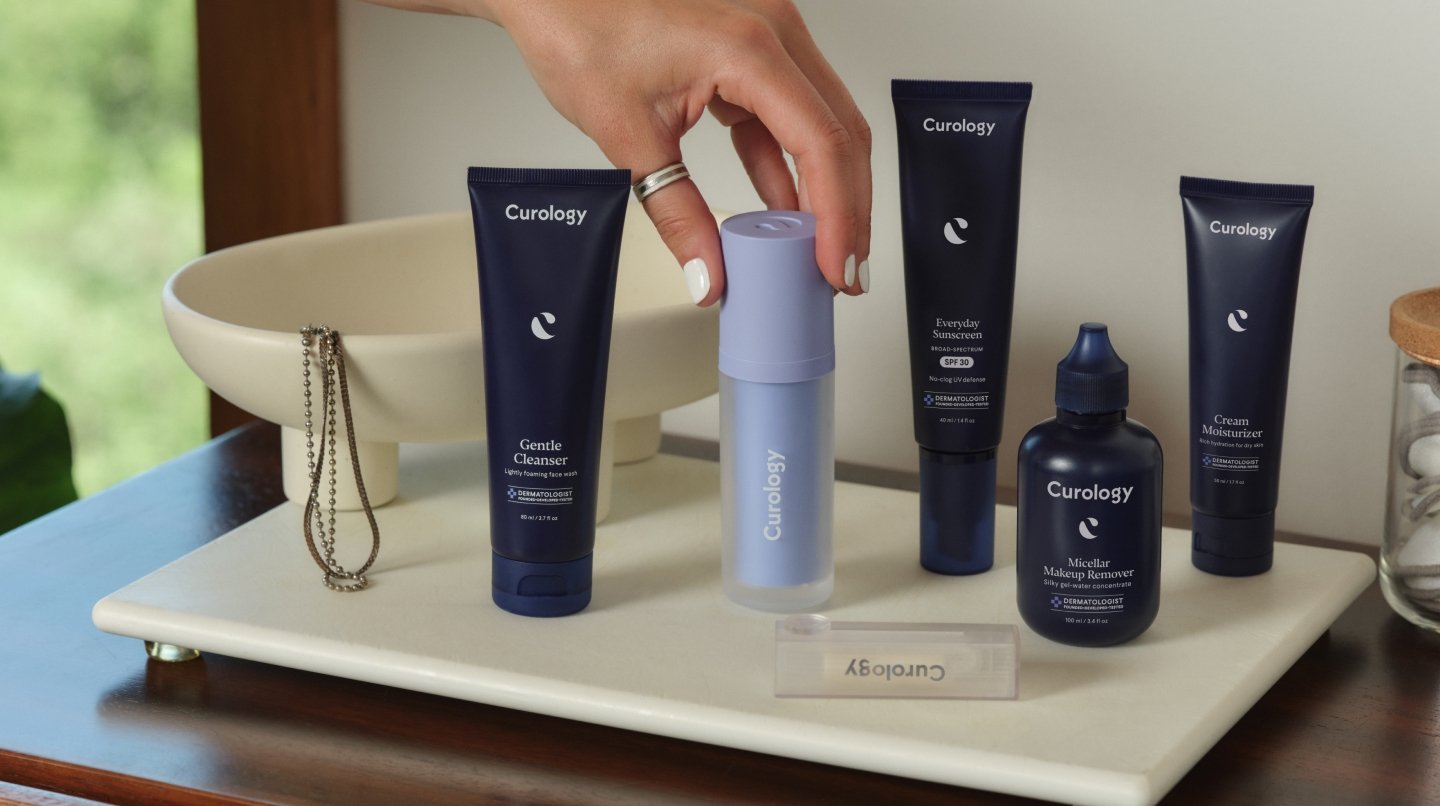How it works:
Share your skin goals and snap selfies
Your dermatology provider prescribes your formula
Apply nightly for happy, healthy skin
How it works:
How it works:
Share your skin goals and snap selfies
Your dermatology provider prescribes your formula
Apply nightly for happy, healthy skin
How it works:
Red alert: How to treat a red face from alcohol
Why your face may turn red when you drink.



For many, a glass of wine, a cold beer, or a sophisticated cocktail can be a delightful way to unwind after a long day. But for some people this form of relaxation can come with an unwanted side effect: facial redness. This is also commonly known as the infamous "alcohol flush" or "Asian flush" due to its common occurrence in those of East Asian descent.
So, what can you do about it? Allow Curology’s skincare experts to break down what you need to know about this phenomenon and how you might be able to help prevent and treat it.
Facial flushing after drinking explained
Facial redness after drinking alcohol—more formally known as alcohol flush reaction—is an often misunderstood bodily response.
Alcohol flush reaction is primarily characterized by a distinct facial redness or flush. Hives, nausea, and a drop in blood pressure may accompany redness in some people. If you have pre-existing conditions like asthma, the reaction can potentially worsen your symptoms. Additionally, alcohol flush can also spark a migraine, adding an additional layer of discomfort.
Alcohol flush reaction isn't merely an inconvenience. In some cases, it carries health implications. The National Institute on Alcohol Abuse and Alcoholism (NIAAA), points out a concerning link between this reaction and a higher risk of certain types of cancer.¹
What causes alcohol flush reaction?
The science behind alcohol flush reaction all comes down to genetics. Contrary to what some might believe, alcohol flush reaction isn’t an allergy to alcohol. Instead, it's a form of alcohol intolerance predominantly caused by inherited variations in certain enzyme genes. These genetic differences impact how efficiently you can metabolize alcohol.
When you drink alcohol, it gets converted into a harmful substance called acetaldehyde inside your body. But don't worry, your body usually has a way to handle it. It uses an enzyme (aldehyde dehydrogenase) to further change acetaldehyde into something that's not harmful.
However, in individuals with the alcohol flush reaction, the process isn't as efficient. If acetaldehyde isn’t metabolized efficiently, it can trigger the release of histamine, a compound involved in local immune responses. This histamine release can trigger the flushing, hives, and other symptoms associated with the alcohol flush reaction.²
So, your red face from alcohol isn't just an embarrassing social hiccup; it's an indication of a deeper metabolic process occurring within your body.
Who is likely to get a red face from alcohol?
Research shows that if you have East Asian ancestry, you’re more likely to experience alcohol flush reaction. This is due to variations in the alcohol dehydrogenase genes that are more common amongst East Asians, affecting the way these individuals metabolize alcohol. However, it's important to note that people of other races and ethnicities can also carry these genetic variations and may experience this flush reaction as well.
In addition to genetic factors, certain medications can also trigger alcohol flushing by altering the metabolism of alcohol. This includes medications used for treating diabetes, high cholesterol, and infections. Notably, a drug called disulfiram, commonly used in the treatment of alcohol use disorder, can cause alcohol metabolism to be altered in a way that leads to unpleasant symptoms such as flushing and nausea when alcohol is consumed.³
How to prevent and treat getting a red face from alcohol
Your red face from alcohol will usually go away on its own after a little while. However, the most effective method to prevent the alcohol flush reaction is to simply abstain from alcohol or limit its consumption.⁴
Alcohol (among other triggers) is also a well known trigger for rosacea. Some research suggests that antihistamines may potentially reduce or prevent the alcohol flush reaction. Antihistamines function by blocking histamine, a compound that’s released during the flush reaction and contributes to the redness and other associated symptoms.⁵
Is red face from alcohol dangerous to my health?
The red face you experience from alcohol—known as alcohol flush reaction—isn't just a temporary cosmetic concern—it could signal potential health risks as well. If you experience this reaction and continue drinking alcohol, you may be at a higher risk for certain types of cancer, including esophageal cancer.⁶⁻⁷
The reasoning behind this elevated risk lies in the nature of alcohol metabolism. When we consume alcohol, our bodies metabolize it into acetaldehyde, a toxic compound. Normally, acetaldehyde is further metabolized into non-toxic molecules, but in individuals with the alcohol flush reaction, this process is less efficient. This leads to higher levels of acetaldehyde in their system after consuming alcohol.⁸ Acetaldehyde is carcinogenic, meaning it has the potential to cause cancer.⁹
However, it's important to remember that this doesn't mean everyone who experiences an alcohol flush reaction will develop cancer. It simply means there's an increased risk, and being aware of this risk can help guide decisions around alcohol consumption.
If you're concerned about alcohol flush reaction and its potential implications for your health, you should speak with a healthcare provider. They can help you understand the root cause of the flush reaction in your specific case and guide you towards appropriate strategies to manage it. Remember, addressing the underlying cause is always more beneficial than merely treating your symptoms.
Is drinking alcohol bad for my skin?
Drinking alcohol, particularly in excess, can have negative consequences for your skin.
One of the ways alcohol impacts your skin is by impairing its antioxidant defense system.¹⁰ Antioxidants are crucial for protecting your skin from environmental damage and maintaining its health and appearance. Alcohol also causes peripheral vasodilation, a process where blood vessels widen, which can lead to the dilation of facial capillaries.
One study found that heavy alcohol consumption, defined as having eight or more drinks per week, was associated with several negative skin outcomes. These include wrinkles around the eyes and forehead, under-eye puffiness, and midface volume loss.¹¹
So, while an occasional drink may not lead to significant skin issues, regular and heavy consumption of alcohol can certainly be detrimental to your skin's health and appearance.
Enjoy clearer and more radiant skin with Curology
Taking care of your skin should be a priority, and sometimes, we all need a little help. Whether you're dealing with premature signs of aging (from alcohol or not) or any other skin concerns such as acne, wrinkles, or pigmentation, a dedicated skin care routine can make all the difference.
Get your personalized skincare routine with Curology
Get your personalized skincare routine with Curology


At Curology, we offer a range of skincare products that can suit your unique skin needs. Our acne cleanser, for instance, is an excellent starting point in your journey to better skin health. It's been specially designed to fight acne-causing bacteria without stripping your skin of its natural moisture. But it doesn’t end with our acne cleanser; explore our range of products now!
FAQs
Time is the best remedy for a red face caused by alcohol. However, avoiding further alcohol consumption can help reduce the redness.
When your face turns red after consuming alcohol, it may be a sign of an alcohol flush reaction. This occurs due to your body's inability to properly break down alcohol, which leads to a buildup of acetaldehyde, a toxic byproduct of alcohol metabolism. This causes dilation of blood vessels and increased blood flow to your face, resulting in the characteristic redness.
It’s important to note that while alcohol flush reaction is not harmful in itself, it may be a sign of a genetic mutation affecting alcohol metabolism and should be considered when drinking alcohol.
While some effects of alcohol on the skin, such as dehydration and inflammation, can be reversed through proper skincare and hydration, other damage such as premature aging may be more difficult to reverse. Seeking professional treatment from a dermatology provider can help you improve the appearance of any alcohol-related skin damage.
P.S. We did the homework so you don’t have to:
The National Institute on Alcohol Abuse and Alcoholism (NIAAA). Alcohol Flush Reaction. (n.d.).
The National Institute on Alcohol Abuse and Alcoholism (NIAAA). Alcohol Flush Reaction. Ibid.
The National Institute on Alcohol Abuse and Alcoholism (NIAAA). Alcohol Flush Reaction. Ibid.
The National Institute on Alcohol Abuse and Alcoholism (NIAAA). Alcohol Flush Reaction. Ibid.
The National Institute on Alcohol Abuse and Alcoholism (NIAAA). Alcohol Flush Reaction. Ibid.
The National Institute on Alcohol Abuse and Alcoholism (NIAAA). Alcohol Flush Reaction. Ibid.
Brooks, P.J., et al. The alcohol flushing response: an unrecognized risk factor for esophageal cancer from alcohol consumption. Public Library of Science Medicine. (2009, March 24).
Brooks, P.J., et al. The alcohol flushing response: an unrecognized risk factor for esophageal cancer from alcohol consumption. Public Library of Science Medicine. Ibid.
Seitz, H.K. and Stickel, F. Acetaldehyde as an underestimated risk factor for cancer development: role of genetics in ethanol metabolism. Genes and Nutrition. Ibid.
Goodman, G.D., et al. Impact of Smoking and Alcohol Use on Facial Aging in Women: Results of a Large Multinational, Multiracial, Cross-sectional Survey. The Journal of Clinical and Aesthetic Dermatology. (August 2019).
Goodman, G.D., et al. Impact of Smoking and Alcohol Use on Facial Aging in Women: Results of a Large Multinational, Multiracial, Cross-sectional Survey. The Journal of Clinical and Aesthetic Dermatology. (August 2019).
Laura Phelan is a board-certified Family Nurse Practitioner at Curology. She earned her Masters of Science in Nursing at Benedictine University and went on to get her post-master’s certificate as a Family Nurse Practitioner at the University of Cincinnati.
* Subject to consultation. Subscription is required. Results may vary.

Curology Team

Laura Phelan, NP-C
Related Articles
Curology package: the cleanser and moisturizer setDoes drinking cause breakouts? Acne and alcohol, explainedThe elimination diet for acneWhat causes acne: food editionThe ultimate guide to rosacea, from causes to treatmentsPopular Articles
Ask Curology: Is my cold breaking me out?Slugging: The dermatologist-approved skincare hack going viral on TikTokTretinoin vs retinol: What’s the difference?How to create a self-care routine that actually sticksYour 2023 skincare horoscopeTry prescription skincare
Get routine essentials

Good skin days ahead
- Breakouts
- Redness
- Fine lines
- Dark spots
- Hair thinning